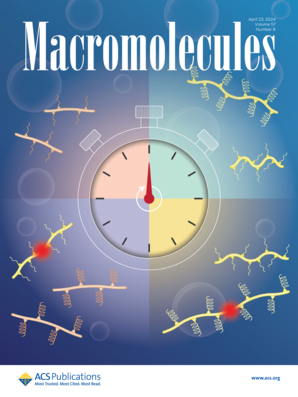调节两亲性梯度共聚物纳米颗粒组装途径和微观结构的聚合诱导自组装
IF 5.2
1区 化学
Q1 POLYMER SCIENCE
引用次数: 0
摘要
聚合诱导自组装(PISA)为设计聚合物纳米粒子提供了一个通用的平台。两亲梯度共聚物的特点是由亲水段逐渐过渡到疏水段,界面张力降低,刺激响应性增强。然而,PISA中聚合和自组装之间的相互作用,受单体投料比和反应性的影响,仍然不清楚。在此,我们采用粗粒度模拟来研究单体之间有效聚合偏倚的作用。我们的研究结果表明,相对单体反应性在共聚物序列和囊泡形成途径中起着关键作用。在低反应性差异下,相似的单体反应性促进了协同聚合-组装过程,产生许多小的球形组装,随后合并并重组成囊泡。相反,高反应性不对称有利于各向异性蠕虫状胶束的形成,这些胶束逐渐融合、弯曲并包裹成囊泡结构。微观结构分析进一步表明,梯度共聚物囊泡具有比嵌段共聚物囊泡更大的内腔。这些见解为定制囊泡形成途径和微调微结构在药物输送和材料科学中的潜在应用提供了指导。本文章由计算机程序翻译,如有差异,请以英文原文为准。
Polymerization-Induced Self-Assembly for Modulating Assembly Pathways and Microstructures of Amphiphilic Gradient Copolymer Nanoparticles
Polymerization-induced self-assembly (PISA) offers a versatile platform for designing polymeric nanoparticles. Amphiphilic gradient copolymers, characterized by a gradual transition from hydrophilic to hydrophobic segments, exhibit reduced interfacial tension and enhanced stimulus responsiveness. However, the interplay between polymerization and self-assembly in PISA, influenced by the monomer feed ratio and reactivity, remains ambiguous. Herein, we employ coarse-grained simulations to investigate the role of the effective polymerization bias between monomers. Our results reveal that the relative monomer reactivity plays a key role in determining both the copolymer sequence and the vesicle formation pathway. At low reactivity differences, comparable monomer reactivities facilitate a cooperative polymerization-assembly process that produces numerous small spherical assemblies, which subsequently merge and reorganize into vesicles. In contrast, high reactivity asymmetry favors the formation of anisotropic worm-like micelles that progressively fuse, bend, and enclose into vesicular structures. Microstructural analysis further shows that gradient copolymer vesicles possess internal cavities larger than those formed from block copolymers. These insights provide guidance for tailoring vesicle formation pathways and fine-tuning microstructures for potential applications in drug delivery and materials science.
求助全文
通过发布文献求助,成功后即可免费获取论文全文。
去求助
来源期刊

Macromolecules
工程技术-高分子科学
CiteScore
9.30
自引率
16.40%
发文量
942
审稿时长
2 months
期刊介绍:
Macromolecules publishes original, fundamental, and impactful research on all aspects of polymer science. Topics of interest include synthesis (e.g., controlled polymerizations, polymerization catalysis, post polymerization modification, new monomer structures and polymer architectures, and polymerization mechanisms/kinetics analysis); phase behavior, thermodynamics, dynamic, and ordering/disordering phenomena (e.g., self-assembly, gelation, crystallization, solution/melt/solid-state characteristics); structure and properties (e.g., mechanical and rheological properties, surface/interfacial characteristics, electronic and transport properties); new state of the art characterization (e.g., spectroscopy, scattering, microscopy, rheology), simulation (e.g., Monte Carlo, molecular dynamics, multi-scale/coarse-grained modeling), and theoretical methods. Renewable/sustainable polymers, polymer networks, responsive polymers, electro-, magneto- and opto-active macromolecules, inorganic polymers, charge-transporting polymers (ion-containing, semiconducting, and conducting), nanostructured polymers, and polymer composites are also of interest. Typical papers published in Macromolecules showcase important and innovative concepts, experimental methods/observations, and theoretical/computational approaches that demonstrate a fundamental advance in the understanding of polymers.
 求助内容:
求助内容: 应助结果提醒方式:
应助结果提醒方式:


